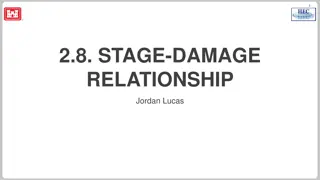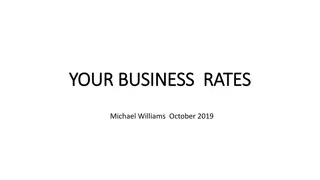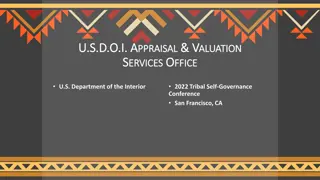Introduction to Valuation with Chris Young, Ph.D.
Join Chris Young, Ph.D., a leading expert in valuation, for an insightful session on the fundamentals of valuation, major components, and practical exercises. Explore topics ranging from economic consulting to recent industry activity and learn from Chris Young's extensive experience as a partner at Red Maple Economics and former head of valuation and commercial damages at Sobel & Co.
Download Presentation

Please find below an Image/Link to download the presentation.
The content on the website is provided AS IS for your information and personal use only. It may not be sold, licensed, or shared on other websites without obtaining consent from the author.If you encounter any issues during the download, it is possible that the publisher has removed the file from their server.
You are allowed to download the files provided on this website for personal or commercial use, subject to the condition that they are used lawfully. All files are the property of their respective owners.
The content on the website is provided AS IS for your information and personal use only. It may not be sold, licensed, or shared on other websites without obtaining consent from the author.
E N D
Presentation Transcript
Introduction to Introduction to Valuation Valuation Chris Young, Ph.D.
Agenda Agenda Quick Introduction What is a Valuation? What are the major components of a Valuation? Simple exercise Mining Business (Opinion of Value) Q&A 2
Economic, Strategic and Forensic Consulting Firm Commercial Economic Damages Estate and Employment Matters Financial Forensics Tax Valuations Economic Studies, Social Science Personal Injury and Wrongful Death Valuations and Corporate Finance Services FINRA Related Matrimonial and Divorce Services Litigation, Estate and Tax, Corporate Finance Matters 3
Team Success Testified and settled $1.7 billion Breach of Contract Case Testified and Settled $120 million Shareholder Oppression Case Verdict of $27 million + Shareholder Oppression Claim Verdict of $30m+ Securities Fraud/RICO Case Been on the opposite side of the majors Analysis Group, BCG, EY, PWC, Brattle Group Been on the opposite side of the mid tier Wiss, Withum, Eisner, Cipolla 4
Recent Activity Recent Activity 5
Speaker Speaker Chris Young Partner Red Maple Economics Former Partner and Head of Valuation and Commercial Damages Sobel & Co. Assistant Professor at Rutgers University, School of Business Previously Professor at Seton Hall University, Stillman School of Business Previously Managing Director of M&A at a mid-market investment bank Previously managed a venture capital fund, CFO of a $500m media company, head of strategy and M&A for the WSJ/Dow Jones PhD, MBA Rutgers University, presently studying Behavioral Economics (MA) Harvard University 6
Lets begin with a simple exercise Lets begin with a simple exercise On a piece of paper write down what you value the most in the entire world [1 min] 8
Lets begin with a simple exercise Lets begin with a simple exercise On a piece of paper now write down why you value this thing, object, person, etc [1 min] 9
Lets begin with a simple exercise Lets begin with a simple exercise On a piece of paper what did you give up to obtain that value? [1 min] 10
Valuation Defined Valuation Defined 1. The act or process of making a judgment about the price or value of something. 2. The estimated value of something. THIS IS ANYTHING THAT HAS VALUE 11
What is a valuation that is accepted by the Court, IRS, strategic partner? 12
One that has a fair level of economic certainty One that has a fair level of economic certainty 1. Act or Process = Must be recognized in the field [academic community, professional use and acceptance] 2. Judgement = Based on economic certainty [empirical data, observation, normative data, expert opinion, court advice, IRS advice] 13
1.Value in Use = specific to a buyer (aka: strategic buyer [typically greater]) 2. Value in Exchange = value to a group of buyers (aka: hypothetical buyer [average]) 14
Does anyone know of the two types of valuations that can be completed? 15
Calculation of Value based on a simple estimate [Less of a fee] Opinion of Value rigorous process 16
Rules v. No Rules Rules v. No Rules When rules exist abide by them (shareholder ggreements, life insurance policies, trust, etc..) When no rules exist most often it is an Opinion of Value unless for mediation or negotiation 17
Misconception #1 Misconception #1 Valuation (valuing the entire business perpetual lost profits) v. Lost Profits Analysis (temporary lost profits analysis) 19
The value of an asset is equal to its historical performance? 20
Misconception #2 Misconception #2 History v. Future History v. Future ABSOLUTELY NOT The value of an asset is based on its expected future performance 21
Opinion of Value Opinion of Value Valuation Analysts Choice Valuation Analysts Choice Valuation Date: December 31, 2014 Valuation Date: December 31, 2014 22
Most Common Approaches Most Common Approaches 1. Income Approach 2. Market Approach 3. Asset Approach 23
Income Approach Income Approach Income Approach (Value) = Sum of the future benefits (cash flows) that will go to the shareholders, but adjusted for risk of not receiving such benefits. CASH IS KING 25
Exercise (Value a 4 year life) [5 Exercise (Value a 4 year life) [5- -Steps] Valuing this business in 2014 Valuing this business in 2014 Steps] 1.Prepare a forecast 2.Identify non-cash expenses 3.Identify the required investment 4.Remove above average expenses 5.Add in expenses not accounted for 26
Step #1 Step #1 Forecast 4 Year Lithium Mining License Forecast Millions 2015 100.0 $ 75.0 25.0 $ 2016 110.0 $ 83.3 26.8 $ 2017 121.0 $ 92.4 28.6 $ 2018 133.1 $ 102.6 30.5 $ Revenue Expenses Operating Income Operating Income Margin 25% 24% 24% 23% 27
Step #2 Step #2 Identify Non Identify Non- -Cash Expenses Cash Expenses Millions 2015 100.0 $ 75.0 25.0 $ 2016 110.0 $ 83.3 26.8 $ 2017 121.0 $ 92.4 28.6 $ 2018 133.1 $ 102.6 30.5 $ Revenue Expenses Operating Income Operating Income Margin 25% 24% 24% 23% Non-Cash Expenses Depreciation Amortization Interest Expense EBITDA EBITDA Margin $ $ 5.0 1.0 6.0 37.0 37% $ $ 6.0 2.0 7.0 41.8 38% $ $ 7.0 3.0 8.0 46.6 39% $ $ 8.0 4.0 9.0 51.5 39% 28
Step #3 Step #3 Identify Capital Needed Identify Capital Needed Millions 2015 100.0 $ 75.0 25.0 $ 2016 110.0 $ 83.3 26.8 $ 2017 121.0 $ 92.4 28.6 $ 2018 133.1 $ 102.6 30.5 $ Revenue Expenses Operating Income Operating Income Margin 25% 24% 24% 23% Non-Cash Expenses Depreciation Amortization Interest Expense EBITDA EBITDA Margin $ $ 5.0 1.0 6.0 37.0 37% $ $ 6.0 2.0 7.0 41.8 38% $ $ 7.0 3.0 8.0 46.6 39% $ $ 8.0 4.0 9.0 51.5 39% Capital Investment Modified Cash Flow MCF Margin $ $ (7.0) 30.0 30% $ $ (8.0) 33.8 31% $ $ (9.0) 37.6 31% $ $ (10.0) 41.5 31% 29
Step #4 and #5 Step #4 and #5 Normalizing Adjustments Normalizing Adjustments Adjustments Remove Compensation Remove Fringe Benefits * boat expense * Ferrari and Bugati expense * vacation to Tahiti * $10m life insurance policy * adjust rent to market prices * non-personal credit card Adjusted MCF $ 1.0 $ 1.0 $ 1.1 $ 1.1 0.100 0.045 0.045 0.025 (0.030) 0.125 31.3 $ 0.100 0.045 0.045 0.025 (0.030) 0.125 35.1 $ 0.100 0.045 0.045 0.025 (0.030) 0.125 39.0 $ 0.100 0.045 0.045 0.025 (0.030) 0.125 43.0 $ Before tax 30
You do not know yet You do not know yet consider risk consider risk The Company is in the business of mining for lithium in Afghanistan. Is this a risky business? If you are an investor, what other opportunities do you have to invest? 32
Calculating the Risk (Discount) Calculating the Risk (Discount) Build Up Method Yield on 20-year US Treasury (Today) Equity Risk Premium Size Premium Industry Premium Geography Premium Company Specific Risk Discount Rate Rates 2.50% 6.50% 10.00% 5.00% 3.00% 5.00% 32.00% Company specific risk, geography and industry may be accounted for in size and equity risk. RANGE: 19.0%-32.0% 33
Bringing It Together Bringing It Together Value of AMCF $ Discounted Cash Flow Adjusted MCF Discount Rate (1+DR)^t Discounted Adjusted MCF VALUE 2015 20.4 $ 1.32 15.43 $ 48.75 $ 2016 22.8 $ 1.74 13.10 $ 2017 25.3 $ 2.30 11.02 $ 2018 27.9 $ 3.04 9.20 $ 96.5 (After tax) 34
Value Matrix Value Matrix (rounded to the nearest million Growth 0% Growth 10% Growth 20% Discount 19% $40.0 $62.0 $90.0 Discount 32.0% $32.0 $49.0 $68.0 Value of marketable, non-controlling interests. 35
Making Other Adjustments Making Other Adjustments Discount for Lack of Marketability Discount for Lack of Control Discount for Voting v. Non Voting Discount for Key Person NOT FACTORED IN HERE Discussed in subsequent sections 36
Market Approach 37
Market Approach Market Approach The Market Approach is a relatively straight forward exercise looking at historical private M&A transactions And / Or The value of publicly traded companies with similar characteristics of the company being valued 38
Market Approach Market Approach Typically we look to understand the value of similar companies which were sold in the market. We look at: Price (Value) to Sales Price to Operating Income Price to EBITDA 39
Market Approach (Assume) Market Approach (Assume) Assume adjusted operating income, EBITDA and sales. 2015 Sales: $100m 2015 Operating Income: $26.3 2015 EBITDA: $37.0 40
Private M & A Transactions Private M & A Transactions 1. 2. 3. 4. Analyzed M & A deals (10 years) Lithium and related companies All sizes All geographies RESULTS: 8 Companies 41
Private M & A Transactions Private M & A Transactions Price-to-Sales Operating Income Price-to- Sales Price to EBITDA Company Year Country Mining Type Price Sales Operating Income EBITDA Botswana Mining 2005 Botswana Lithium $1,000,000,000 $79,800,000 ($45,800,000) ($44,200,000) 12.53 (21.83) (22.62) Afghanistan, greater middle east Afghanistans Futures 2015 Lithium $62,000,000 $81,000,000 $9,700,000 $10,500,000 0.77 6.39 5.90 Amercian Lithium 2015 US, Europe Lithium and Ag. $99,800,000 $106,920,000 $8,100,000 $11,000,000 0.93 12.32 9.07 London Enterprises 2015 Europe Lithium and Ag. $212,000,000 $200,000,000 $18,000,000 $19,800,000 1.06 11.78 10.71 Eastern Europe, Ukraine, Russia Lithium and Diamonds Russian Federation 2013 $477,000,000 $450,000,000 $22,500,000 $24,750,000 1.06 21.20 19.27 Lithium, Ore. Copper Social Growth Fund 2012 Columbia, Brazil $22,500,000 $27,000,000 $6,750,000 $7,560,000 0.83 3.33 2.98 Ore, Copper, Gold, Silver Webers Interntional Gr. 2011 Mumbai $18,500,000 $27,500,000 $8,250,000 $9,625,000 0.67 2.24 1.92 Lithium and other gas Iraqi National Gas 2011 Iraq, Jordan $132,000,000 $102,000,000 $40,800,000 $42,840,000 1.29 3.24 3.08 1.00 2.39 4.86 4.83 4.49 3.79 Median Mean What do we choose? What is a fair comparable? 42
Private M & A Transactions Private M & A Transactions Price-to- Sales Operating Income Operating Income Price-to- Sales Price to EBITDA Company Year Country Mining Type Price Sales EBITDA Afghanistan, greater middle east Afghanistans Futures 2015 Lithium $62,000,000 $81,000,000 $9,700,000 $10,500,000 0.77 6.39 5.90 Lithium and other gas Iraqi National Gas 2011 Iraq, Jordan $132,000,000 $102,000,000 $40,800,000 $42,840,000 1.29 3.24 3.08 1.03 1.03 4.81 4.81 4.49 4.49 Median Mean We remove old, geo , and type first 43
Application of Multiples (Private) Application of Multiples (Private) Sales: $100m * 1.03 = $103m Operating Income: $26.3 * 4.81 = $126.5m EBITDA: $37.0 * 4.49 = $166.1m 44
Publicly Traded Comparables Publicly Traded Comparables Company FMC Talison Lithium Western Lithium Galaxy Resources New World Resources Most Recent Quarter 2015 2015 2015 2015 2015 Domicile Operating Income Price-to-Sales USA $676m USA $26m USA -$4m Australia -$84.5m USA $358.6m Price-to-Operating Income Price-to-EBITDA 12.10 1.06 1.25 1.06 0.94 1.39 5.70 6.00 4.96 5.22 10.53 6.96 3.57 8.00 4.10 Median Mean 1.06 1.14 6.00 7.18 5.22 6.25 Seems like the only comparable is Talison Lithium 45
Application of Multiples (Public) Application of Multiples (Public) Sales: $100m * 1.25 = $125m Operating Income: $26.3 * 6.0 = $157.8m EBITDA: $37.0 * 5.2 = $192.4 46
Asset Approach 47
Asset Approach Asset Approach 1. Adjust the balance sheet based on market values for inventory, fixed assets, real estate and other assets 2. Adjust the balance sheet to accommodate the market value of debt 3. Take the difference between the market value of assets and the market value of debt 48
Appraisers Appraisers 1. Appraisers provide us an adjusted value for inventory or equipment 2. A real estate appraiser values the property 3. All other assets and liabilities remain the same [MANY TIMES THIS CAN CREATE TIME CHALLENGES FOR ATTORNEYS] 49
31-Mar-15 Balance Balance Sheet Sheet Balance Sheet ASSETS Cash Accounts Receivable Inventory (Lithium) Current Assets GAAP 5,000,000 12,000,000 32,000,000 49,000,000 Fixed Assets (Cost) Accumulated Depreciation 108,000,000 25,000,000 83,000,000 Other Prepaid License Total Assets 1,200,000 7,000,000 140,200,000 $200,000,000 LIABILITIES Accounts Payable Accrued Expenses Short Term Debt Current Liabilities $ $ 7,500,000 9,000,000 7,500,000 24,000,000 $24,000,000 $47,000,000 Long Term Debt $ 47,000,000 $129,000,000 50 Shareholders Equity 69,200,000























